|
|
|
|||
|
|
||||
|
|
||||
| The (Jet)X Files | ||||
|
|
HOME | SITE MAP | FORUM | CONTACT |
|
||
|
ABOUT | MOTORS | MODELS | ARCHIVE | HISTORY | STORE | FAQ | LINKS
|
|
|
|
|
|
|||||||||||||||||||||||||||||||||||||||||||||||||||||||||||||||||||||
|
The (Jet)X Files 3
(March 2003)
by Roger Simmonds Reprinted from SAM 35 Speaks, March 2003 (with additional illustrations) First, thank you to all who say they like the column. David Simmonds (no relation) reminisces about his ‘Tailored’ Hawker Hunter for Jetmaster [below right]: “The Hunter was (still is) my favourite jet fighter and I finished it in the prototype ‘eau de nil’ pale green finish. The moulded balsa fuselage halves were superb, although extremely fragile until assembled around the augmenter tube, and I covered mine in lightweight tissue doped on. The Hunter flew very well, but only climbed to about 12-15 feet in a straight line, looking extremely realistic and with surprisingly great glide. |
|
|||||||||||||||||||||||||||||||||||||||||||||||||||||||||||||||||||||

“I lost this model one hot summer’s day. I had been experimenting with putting ‘re-heat’ in the motor by cutting a fuel pellet in half and winding some fuse between the halves! It worked after a fashion, and when the second fuse ignited, the model was already at about 10 feet. It shot to the highest it had ever been, gliding straight over a nice slope on my flying field, over the fence and into the middle of a field of standing wheat. I did eventually get it back as I was friendly with the farmer and he assured me that he would look out for it at harvest time, which he did. By then it was in a sorry state and it never flew again.” After too many years in the doldrums, there is a real hubris in today’s ‘small jet’ scene and many classic designs are being rediscovered and interesting new ones tried out. If there was any doubt about the spectator appeal of free flight in general and small jet planes in particular, the following is a true story of a meeting at old Warden. This was not a SAM event, (though most of the usual suspects were there) and there were some very professional and sophisticated demonstrations of R/C helicopters and turbojet planes taking place in another part of the field. I looked over there from time to time. There were some folk watching who I’m sure were thrilled, but the majority of spectators appeared to be at the freeflight line. Tiny jets have realism and excitement that the large jet could not emulate. Perhaps the knowledge that our models are unguided and nobody has any idea what they will do next has something to do with their charisma. I believe we are a good showcase for SAM and represent what one aspect of ‘vintage’ modelling is all about. Some folk are converting early duration models (Fizzle Quick, Arrow 50, Snowflake, Vindskreenviper and the like) to Rapier power. There will no doubt be Rapier competition rules in due course (if there aren’t already, can anyone enlighten me?). Scale types, already well served by the Veron, Skyleada and Keil Kraft Flying Scale series, are discovering how many different, though sometimes elusive, period designs are out there. Peter Williams and David Lloyd-Jones still offer their services, and a search of a few internet sites (Jetex.org and Jetex.org.uk are good places to start) will generally reveal a source of plans and relevant copies of Aeromodeller, Model Aircraft, or American publications. I will be very happy to help readers track down an old plan. As an aside, I seem to remember there was a plan or kit for an X-15 in the early sixties. Was there ever one in the Flying Scale, or other, series? It may be thought that since there is such a rich archive of scale plans from 1948 onwards, no committed SAM type would ever wish to stray, and make a new design. Small hope! For some, the creative impulse is not quite satiated by modifying a Jetex model for Rapier power, and modelling a previously virginal prototype with all of today’s resources is just too tempting. I myself cannot compete in quality or quantity of models with the today’s luminaries, but what I can do is to plough my own furrow, exploring byways and esoterica and perhaps advance our hobby just a little. I am experimenting with Rapiers and augmenter tubes, and I will report the results in due course. |
|
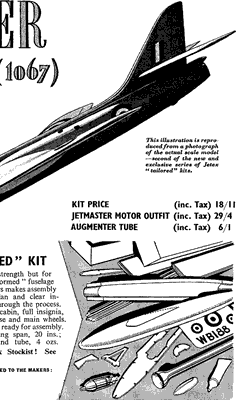 |
||||||||||||||||||||||||||||||||||||||||||||||||||||||||||||||||||||
|
|
|
|||
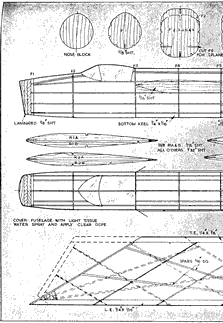
|
|
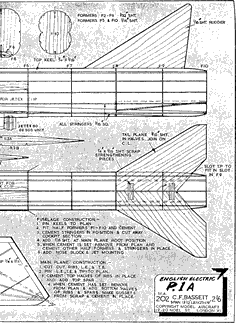
- Model Aircraft, Jan. 1955
|
||
|
Starting with kits, Aerographics now include an interesting German ‘might have beens’, in the Flitzer, and a very tasty Canberra, designed by the ever-diligent Richard Crossley, is being developed. There are a number of new plans including a smaller version of Bill Dean’s MiG 15 for L2, (Dave Bonnington, Model Flyer, March 2001) a very neat Saab J 29 for L1 and an accurate Skyray for L2 (Mike Stuart, both in FDM&C). There is a Douglas Skystreak, (Flying Scale Models, March 2002). British research projects are represented by a wonderful little Miles M.52 of the late forties (Model Flyer, June 2001). This was still secret after the war and could not have been modelled then, a great pity. This is just a selection of models (I have not covered the many old and new models of American origin) which complement what was readily available fifty years ago. Some recent models that duplicate past efforts (for example the Skyray) are superior to the original product, and the Aerographics Lightning for L4 or L2HP (designed by Pete Smart) [right] is far better than the old P.1A plan. This kit is very tempting; though I would want to ‘back modify’ it the P.1A, which shouldn’t be too difficult. |
 for Rapier L1
- Graham Potter ed. JMC
|
|||
|
Many old plans stimulate one’s own creativity, despite, or even because of, design features that appear questionable, to say the very least. The wing and fin, but not the fuselage, for my own D.H. 108 Swallow were adapted from the July 1952 Aeromodeller [right]. This had an enclosed Jetex 100, without augmenter tube, in a ‘hollow log’ fuselage. Hollow logs were for real craftsmen only, and this feature alone must have put off many potential builders. Other plans are both fascinating and infuriating. John Darnell’s Folland Midge for Jetex 50 and augmenter tube (Aeromodeller, March 1955, shown below right) is a most quirky design. The wing is carved from solid The many wonderful models seen at SAM and other events can be daunting to us lesser mortals but they can also spur one’s own efforts. Those I remember from last season include a twin engined Airbus and a Martin B 51, Graham Knight’s early Heinkel 178 and Pete Smart’s F-86 Sabre (a tricky design to trim) and bright yellow Folland Gnat. This latter model for L1 is a real tissue-covered beauty and a real contrast to the Midge discussed above. I never saw his FD 2, (which inspired my own effort) fly. Then there was Chris Strachan’s sinister all black Lockheed U2 for L2 power. This had an 18" high aspect ratio wing, which ought to encourage predictable flight pattern and a good glide. At that time it seemed prone to turning in and I will try to incorporate some elliptical dihedral in my own copy. Whilst all ‘one-offs’ reflect the designers’ particular passions in choice of subject some use idiosyncratic building techniques that may not be reproducible by anybody else. Other models, though more straightforward, have to remain inspirational because the plan, even if there ever was one, is not available. Should one pluck up the courage to ask for a plan after an exceptional flight, the traditional answer in such circumstances, “Plan, what plan?” is normal. There are exceptions of course, and designers who have mastered CAD packages have a distinct advantage in promulgating their creations. |

- Aeromodeller, July 1952 (p. 399)
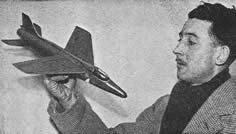 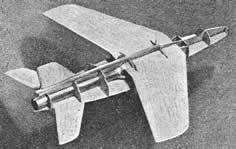 for augmented Jetex 50
- Aeromodeller, Mar. 1955 (p. 149)
|
|||
|
I have given two examples of questionable designs, but how does a competent period design compare with a good modern one? Richard Crossley’s Canberra B1 for Rapier power [right] is typical of his elegance and economy (it takes real skill to design a simple structure, whilst an old bodger like me can design a complex one) and it makes an interesting comparison to the Skyleada model of 1953/54. Both are for a single motor in the fuselage, which is not too much of an imposition as several Canberra variants had rocket-assist. Richard’s is for the L2 and has a span of 14" for a weight of 30-35 g, whereas the Skyleada design was for a Jetex 100, with a span of 21" and a weight of 2oz (56g). This has a more complex wing with a semi-symmetrical profile set at an angle to the fuselage and a built up tail, whilst the smaller version has flat-bottomed wing mounted directly on the fuselage keel and an all sheet fin and tail, sensible at this size. It is difficult to put one’s finger on any real differences, apart from the size, but the version for Rapier is simpler and easier to build accurately, and this alone is ample justification for the new design. Nevertheless, the Skyleada Canberra and many other period designs really can be a delight to build, if one has the time (and has the Jetex motor and fuel necessary to power the larger models). With the deft use of modern adhesives such as cyano or epoxy and carbon fibre a lighter and stronger model might also be achieved. |
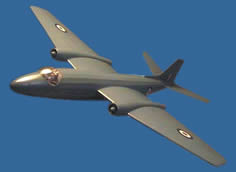
- Richard Crossley ed. JMC
|
|||
|
Like many SAM members, I enjoy researching a difficult subject and hunting down old aviation books, though I’ve learned the hard way not to trust their drawings. Studying old designs can inspire, delight and exasperate at the same time, and offer historical insights into the post war period. Looking at some of the published plans of the period, however, one might even begin to think there is such a thing as progress. |
||||
|
|
||||
|
|
|
|||
|
|
|
|
|
|
|
|
Acknowledgements - Article: Roger Simmonds - Illustrations: Roger Simmonds, Richard Crossley, Bill Henderson, MAAC archives via Bill Henderson, Graham Potter |
|
|
|
|
ABOUT | MOTORS | MODELS | ARCHIVE | HISTORY | STORE | FAQ | LINKS |
|
|
Terms of Use
|
Queries? Corrections? Additions?
Please
contact us.
|
|